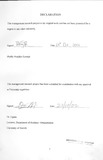| dc.contributor.author | Karanja, P W | |
| dc.date.accessioned | 2013-06-22T09:26:24Z | |
| dc.date.available | 2013-06-22T09:26:24Z | |
| dc.date.issued | 1998 | |
| dc.identifier.citation | Degree Of Master of Business and Administration | en |
| dc.identifier.uri | http://erepository.uonbi.ac.ke:8080/xmlui/handle/123456789/38096 | |
| dc.description | A management project submitted in partial fulfilment
of the requirements for the Degree of Masters In
Business Administration, Faculty of Commerce,
University of Nairobi | en |
| dc.description.abstract | The real estate industry in Kenya has largely grown in size in the recent past 20 years.
From previously a small industry that was largely unknown, it is now a constantly
expandingindustry with many new participants.
The industry however remains very complex in its operations with matters of real estate
ownership and transfer being very sensitive issues among the Kenyan citizens. The
government in its bid to regularize the dealings in the market has in introduced various
regulatory controls in form of Acts and policies. These, together with the fact that real
estate is a very inelastic product and most of all immobile have rendered the participation
in the industry very hard.
The changes in the industry environment together with the increasing competition has
caused the firms to change their competitive strategies in order to achieve profitability
and maintain their survival in the market.
The study sought to establish the various strategies that the firms were employing. Porte's
generic strategies were the basis of the study because they are applicable to all kinds of
industries whether based on service or goods. The study data was based on a sample of
39 firms. The data was collected through questionnaires. 45 questionnaires were
administered through drop and pick later appro~ch because of the unavailability of the
owners and 39 responded.
The .findings of the study indicate that the most commonly utilized strategy was
differentiation focus followed by differentiation broad. Cost leadership strategies were
found unpopular among firms in the industry.
Many firms adopted the competitive advantage strategy based on differentiation as
opposed to cost leadership. Differentiation places the firms at high ranking in terms of
qualityand customer service, issues that are key to attracting and maintaining clientele.
The competitive scope preferred was narrow, with many firms choosing to specialize in
one section of the market mainly the middle to high income residentialproperties.
The firms faced various challenges in the process of trying to maintain a competitive
position in the market. The greatest challenges were identified as the rising levels of
inflation and interest rates and the reduced disposable income available for real estate
investment and for use in rental payments. Competition from unregistered practioners
also came high as a challenge for the registered firms due to the unhealthy competition
that they brought forth. | en |
| dc.language.iso | en | en |
| dc.title | Competitive strategies of real estate | en |
| dc.type | Thesis | en |
| local.publisher | Faculty of Commerce | en |

